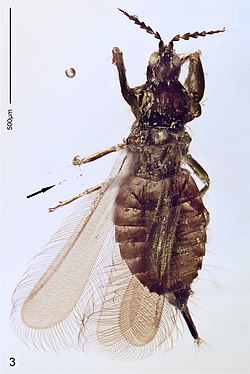| Rohrthrips Temporal range: Early Cretaceous | |
|---|---|
 | |
| Rohrthrips jiewenae | |
| Scientific classification | |
| Kingdom: | Animalia |
| Phylum: | Arthropoda |
| Class: | Insecta |
| Order: | Thysanoptera |
| Suborder: | Tubulifera |
| Family: | † Rohrthripidae Ulitzka, 2018 |
| Genus: | † Rohrthrips Nel et al, 2010 [2] |
Rohrthrips is a fossil genus of thrips in the family Phlaeothripidae.
Fossils are only found in amber, collected from Lebanon [1] and Myanmar.